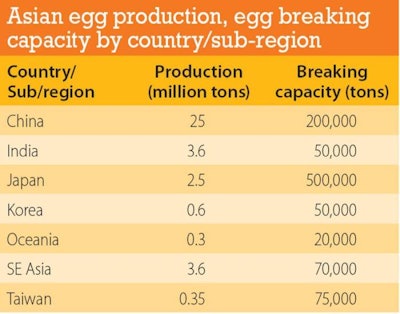
While the percentage of eggs currently processed in Asia may be small when compared to Europe or North America's numbers, the sector can only be expected to grow.
However, Sanovo's Morgan Ernst pointed out at the International Egg Commission's Cape Town conference that the industry in the region can hardly be described as being in its infancy - China was home to a surplus of 100 egg-drying plants over a century ago!
Asia is home to 3.5 billion people and produces 35 million tons of eggs annually - 60 percent of global production. With the exception of Japan, Asia only processes 1 percent of its eggs, while in the U.S. and EU, the figure is approximately 30 percent. Worldwide, this figure stands at 7 percent, meaning that the opportunities for the sector to grow are numerous.
Japan
Japan is Asia's most sophisticated egg processor, and it processes a higher percentage of eggs than any other Asian country. It produces 2.5 million tons of eggs each year and 500,000 tons, or 20 percent, are processed into products by the egg industry. Additionally, 750,000 tons, or 30 percent, are converted into products in-house by institutional or food service businesses. Approximately 130,000 tons are powdered or frozen.
The intake of eggs by Japanese consumers in product form is about 50 percent.
About 230,000 tons - or 9 percent of all eggs produced in Japan - are transformed by food concern Kewpie, which has over 20 egg products plants in its home market as well as factories overseas.
China
In 2013, it was estimated that there are 22 egg processors in China and four or five new plants expected to come on stream in 2014. Additionally, a significant proportion of egg processing is carried out in-house. There is growing demand in China for safe egg products in the country, suggesting the need for change and investment in the sector. The growth of large integrated layer farms is also expected to change the sector further.
India
There are four egg-drying plants in India, and 98 percent of production is exported. It is the largest processed eggs operation in Asia, transforming 50,000 tons of eggs annually.
Asian living standards are improving and diets changing, with greater demand for processed foods. Given the volume of eggs produced, the number of inhabitants and the currently low percentage of eggs processed, it is worth considering how many eggs will be transformed each year, should the percentage processed reach European or U.S. levels.


















